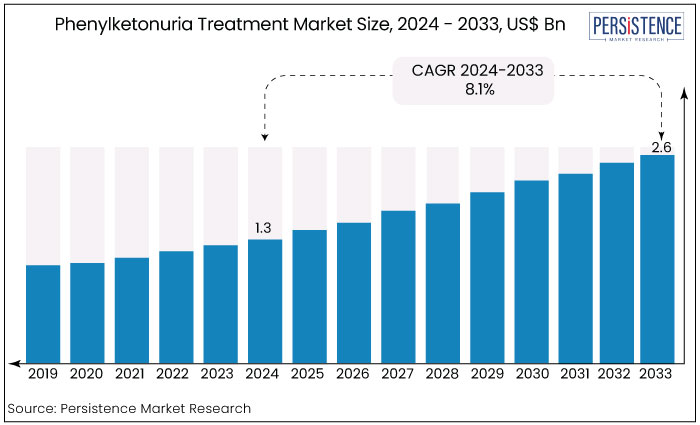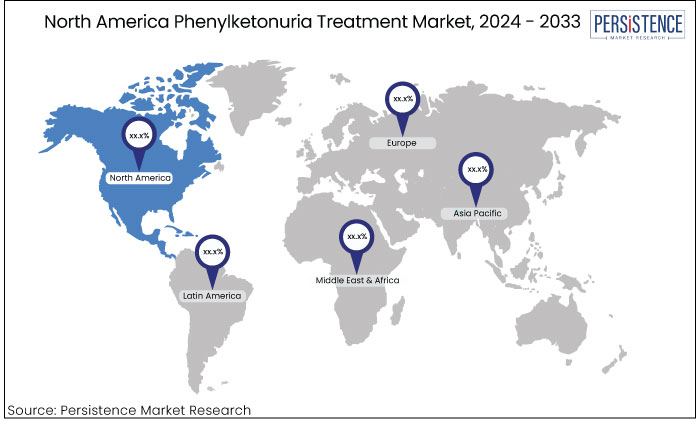PMR Foresees a Robust Growth Outlook for the Phenylketonuria Treatment Market Owing to the Rising Awareness, and Development of Novel Therapies
Industry: Healthcare
Published Date: June-2024
Format: PPT*, PDF, EXCEL
Delivery Timelines: Contact Sales
Number of Pages: 150
Report ID: PMRREP14410
The phenylketonuria treatment market is estimated to reach a valuation of US$2.6 Bn by the year 2033 up from US$1.3 Bn attained in 2023, at an estimated CAGR of 8.1%, during the forecast period 2024 to 2033.

Key Highlights of the Market
|
Attributes |
Key Insights |
|
Market Size (2023) |
US$1.3 Bn |
|
Market Size (2033) |
US$2.6 Bn |
|
Forecast Growth Rate (CAGR 2024 to 2033) |
8.1% |
|
Historical Growth Rate (CAGR 2019 to 2023) |
5.2% |
PKU, a rare metabolic disorder resulting in the inability of the human body to break down the amino acids called phenylalanine, causes severe brain damage, and other neurological problems. The treatment is critical, primarily driving the demand in global market for PKU treatment.
The PKU treatment market size is projected to grow at a strong rate during the forecast period, owing to the growing prevalence of PKU and the necessary awareness campaigns among the healthcare industry, and patients.
Currently, the treatment for PKU involves a low-phenylketonuria diet, which can be tough to adhere to and requires the supplement of specialized medical foods.
Pharmacological treatments are in line with the dietary management for treating PKU, which includes sapropterin dihydrochloride, a synthetic form of tetrahydrobioprotein (BH4), which is a necessary co-factor for PKU metabolism.
The phenylketonuria treatment market a growth rate of 5.2% during the historic period from 2019 to 2022. The market size is said to witness a surge in market demand owing to the growing PKU awareness and the gradually increasing number of patients diagnosed with PKU.
According to a report by the National Organization for Rare Disorders, PKU affects approximately one in every 10,000 to 15,000 new-borns worldwide. This number is expected to increase due to factors such as increased genetic testing and new-born screening.
Another factor contributing to market growth is the increasing awareness of PKU among healthcare professionals and patients. As awareness of the disorder grows, there is a growing demand for effective treatments that can improve patient outcomes and quality of life.
The phenylketonuria treatment market size is primarily growing by the introduction of novel therapies and enhancements to existing products. Pharmaceutical companies are investing heavily in research and development to introduce new treatments and improve existing ones.
Increasing Prevalence of Phenylketonuria
The increasing prevalence of PKU acts as a major driving element for the phenylketonuria treatment market, which has led to an increase in the number of patients seeking treatment for the condition.
With the increased number of patients diagnosed with PKU, the demand for effective treatment is predicted to grow rapidly over the forecast period.
Phenylketonuria (PKU) is a rare genetic disorder that affects the human body's ability to process the amino acid phenylalanine. If left untreated, it can cause intellectual disability and other health problems.
As a result, the demand for effective treatments for the disorder is growing, and this is one of the most prominent drivers of the phenylketonuria treatment market.
Technological Advancements, and Government Initiatives
Another key driver is the technological advancements in PKU diagnostics, which led to earlier and more accurate diagnoses of the disorder, which has increased demand for PKU therapeutics.
Early diagnosis of the disorder can help prevent the development of more severe symptoms, hence, several government authorities globally are taking initiatives to raise awareness about PKU and to fund research and development of effective therapeutics for the disorder.
Such initiatives helped to create a more favorable regulatory environment and aided the increased funding for research and development activities, eventually aiding the phenylketonuria treatment market share globally.
High-Cost of Treatment
The only major restraining factor for the phenylketonuria treatment market is the high costs incurred for its treatment, making it difficult for patients to afford the treatment.
The expensive diet plans, including medical foods and supplements, can add up to the overall PKU treatment cost, making the treatment more expensive for the patients.
Further, many insurance companies do not include the total cost of PKU treatment, which is another factor hindering the phenylketonuria market size over the forecast period.
Patients diagnosed with PKU have fewer treatment alternatives and many of these treatments do not react well to the current therapies.
The phenylketonuria treatment market confronts several difficulties, such as low diagnosis and awareness, expensive therapy, few treatment options, problems with compliance, and social stigma and isolation.
To overcome these obstacles, cooperation between patients, medical professionals, researchers, and legislators will be necessary to enhance diagnosis, create more accessible and efficient therapies, and offer patient and family resources.
Another major challenge for the growth of the market is the lack of awareness and the prevalence of under-diagnosis, as several patients are completely unaware of the disorder and are left undiagnosed, leading to poor health conditions and delayed treatment.
Robust R&D Activity
Ongoing research and development activities to create efficient medications, treatment and early diagnosis methods create a pool of opportunities for the market.
Due to the lack of awareness and high costs incurred, several patients are unable to receive treatment for the disorder, and many patients are undiagnosed for PKU, which creates a wide range of opportunities for the key market players.
With the continuous R&D activities for the diagnosis and treatment methods for PKU disorder, it will be easier for patients to get an early diagnosis of their disorder and get the necessary treatment as early as possible.
Furthermore, the researchers are trying to utilize the latest technologies for the diagnosis with efficient and affordable treatment options, which can aid the phenylketonuria market growth while helping the patients get the right treatment at the early stages of their disorder.
Hospitals Represent Nearly 55% Market Share
|
Market Segment by Distribution Channel |
Market Value Share |
|
Hospitals |
55% |
Based on the distribution channels, the market is further sub-segmented into hospital, retail and online, where the hospital sub-segment dominates the market share.
Hospitals, and specialty clinics offer expert care diagnostic resources and treatment to their patients, hence are the initial point of contact for patients suffering from PKU.
Additionally, patients with complex or severe instances of PKU might receive complete care from these clinics due to their experience and resources.
Furthermore, a lot of phenylketonuria therapies need to be administered or monitored by specialists, like intravitreal injections or electroretinography tests, which are usually carried out in hospitals or specialty clinics.
Due to the specialized treatment and knowledge offered by hospitals and specialty clinics, these are expected to dominate the market share over the forecast period.
Parenteral Administration
|
Market Segment by Route of Administration |
Market Value Share |
|
Parenteral |
60% |
Based on the route of administration segment, the PKU treatment market is further divided into parenteral and oral route of administration, where the parenteral route of administration owns the major market share.
The parenteral route of administration or treatment is more effective than the oral route, as it delivers the medication more quickly and precisely by injecting it directly into the circulation or the affected area.
Due to this advantage, the parenteral route of administration or the injectable method is estimated to own a substantial market share of the global phenylketonuria treatment market.
Furthermore, when oral medications may not be appropriate, such as for patients who have trouble swallowing or who need larger doses than may be possible with oral medications, parenteral treatments are also recommended.
The parenteral segment is dominated in part by the fact that there are currently a number of well-established parenteral therapies for PKU treatment.
North America Maintains a Prime Position in PKU Treatment Research
North America dominates the global market share for the market owing to the high level of awareness and understanding of the PKU disorder among US healthcare providers and residents.
Due to this, there has been an increased diagnosis and a better treatment and management of the PKU disorder which eventually contributes to the overall patient outcomes and leads the North American region to earn a substantial market share of the global KPU treatment market.
Furthermore, the presence of well-established and high-end healthcare facilities in the US, Canada, and other parts, helps the region to boost the market’s growth and create a favorable environment for the growth and development of the commercialization of the crucial healthcare and diagnosis products or medical electronic devices which eventually aids the North American region to dominate the global market share.
Europe All Set for Fastest Growth
Europe is expected to have the highest growth rate during the forecast period, owing to the advent of the generic version of medicinal drugs used for the treatment of KPU disorder.
The presence of major healthcare companies and medical electronics manufacturers in the European region, and the high healthcare expenditure also aids the growth of the KPU treatment market in the European region.

January 2023-
In January 2023, Jnana Therapeutics announced that it was granted a clearance certificate from the FDA for the Investigational New Drug (IND) application for its drug named JNT-517, which was developed to treat PKU.
July 2022 -
In July 2022, Jnana Therapeutics reported the preclinical evidence for its flagship program, to create the first-ever oral strategy to treat PKU, at Vancouver, Washington.
The major competitors in the phenylketonuria treatment market are primarily evaluated based on their product or service offerings, their financial statements, developments and the approaches implemented, the company's position in the global market scenario and its geographical reach.
Apart from this, the key competitors studied have also been accessed through the SWOT analysis to understand their strengths, weaknesses, opportunities and threats.
Apart from this, the key competitors in the industry employ crucial strategies like partnership deals, mergers and acquisitions, and business expansion deals to strengthen their hold on a particular region or a particular service offering.
|
Attributes |
Details |
|
Forecast Period |
2024 - 2033 |
|
Historical Data Available for |
2019 - 2023 |
|
Market Analysis |
US$ Billion for Value |
|
Key Countries Covered |
|
|
Key Companies Profiled |
|
|
Pricing |
Available upon request |
By Distribution Channel
By Route of Administration
By Region
To know more about delivery timeline for this report Contact Sales

The global phenylketonuria treatment market size was around US$1.3 billion as of 2023.
North America currently leads the global PKU treatment market.
Europe is predicted to have the highest growth rate during the forecast period.
Arla Foods Ingredients Group P/S, Archer Daniels Midland Company, BASF SE, Chr. Hansen, and Cargill are some of the leading players in the market.
Hospitals represent the leading market segment by end-use industry.